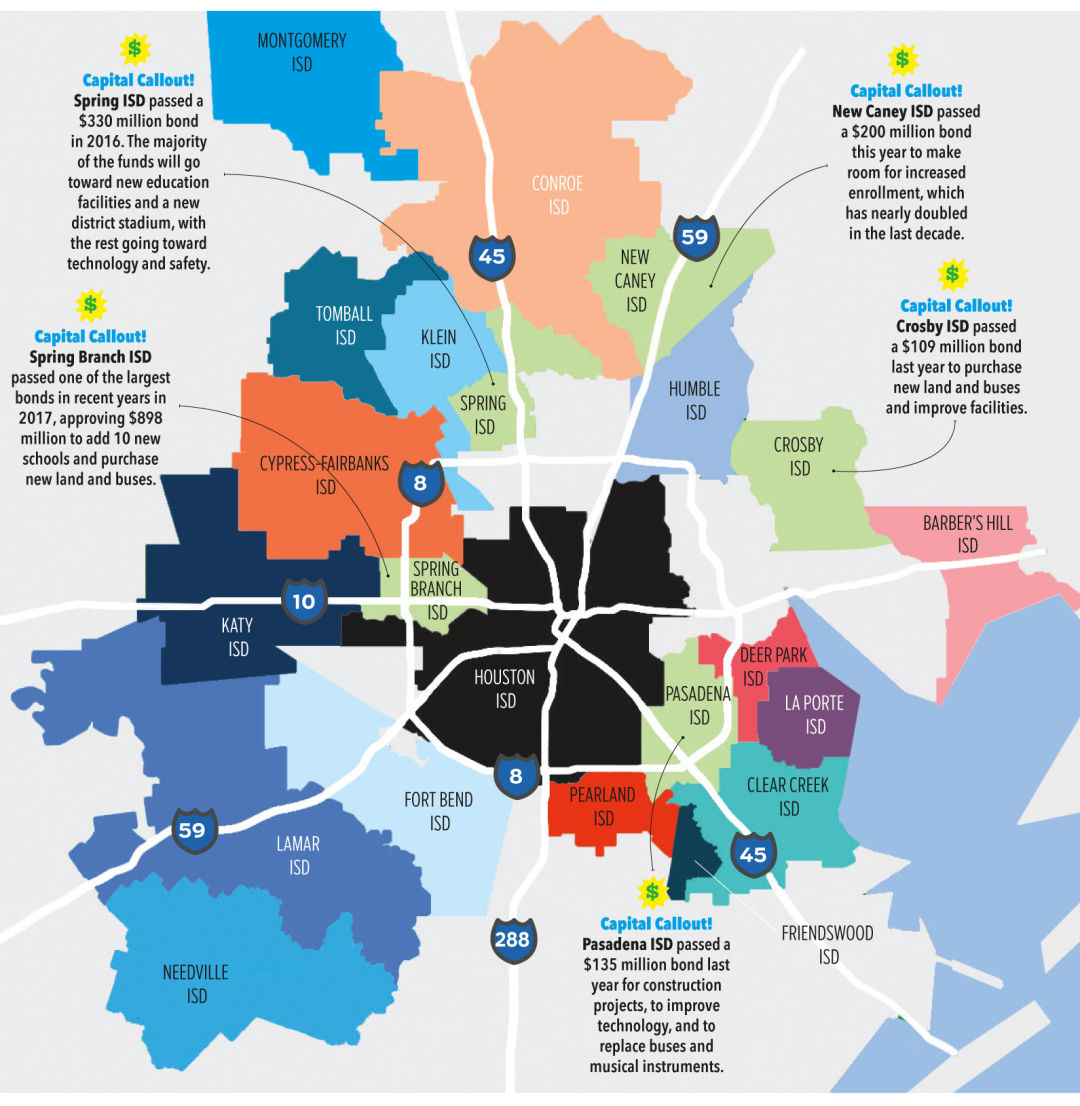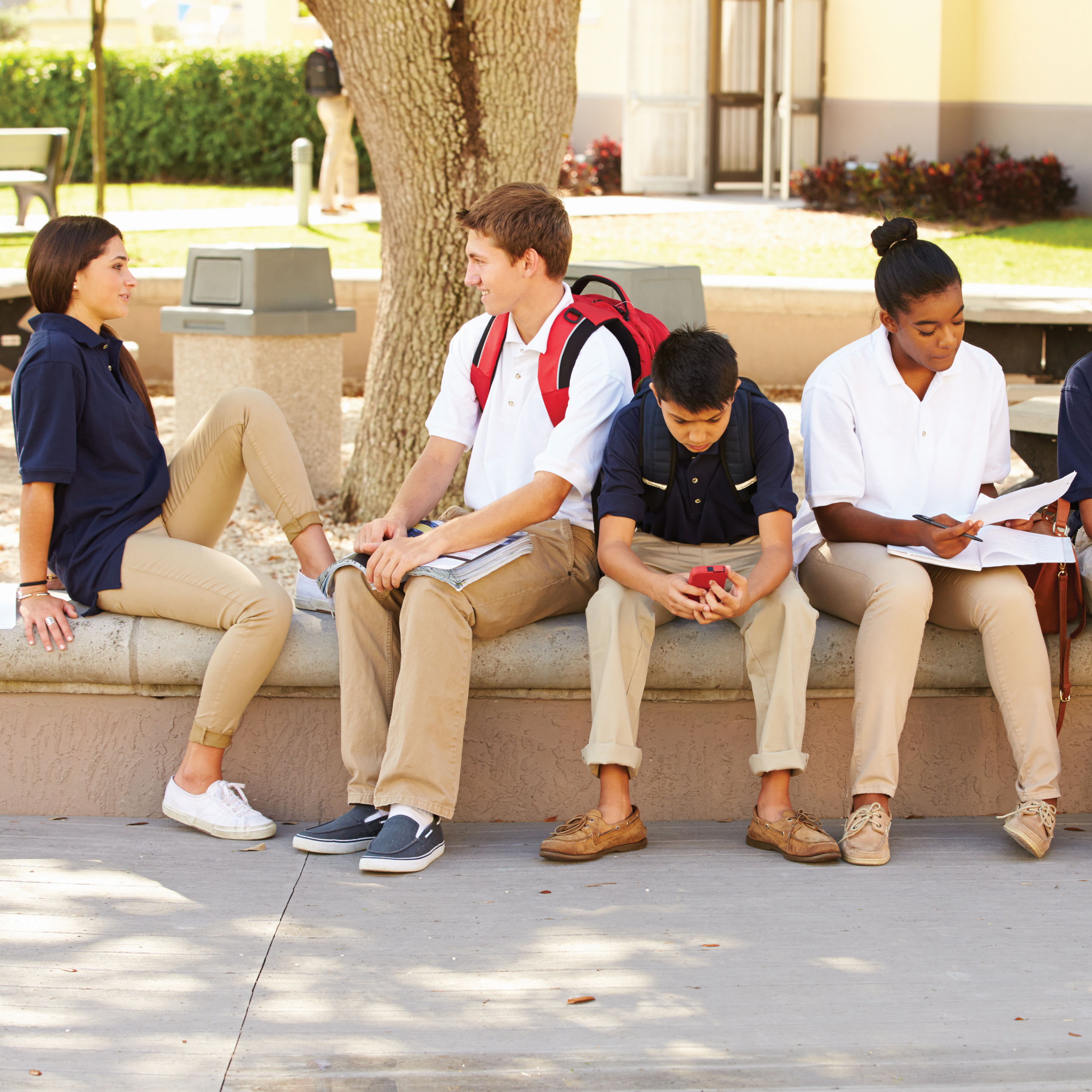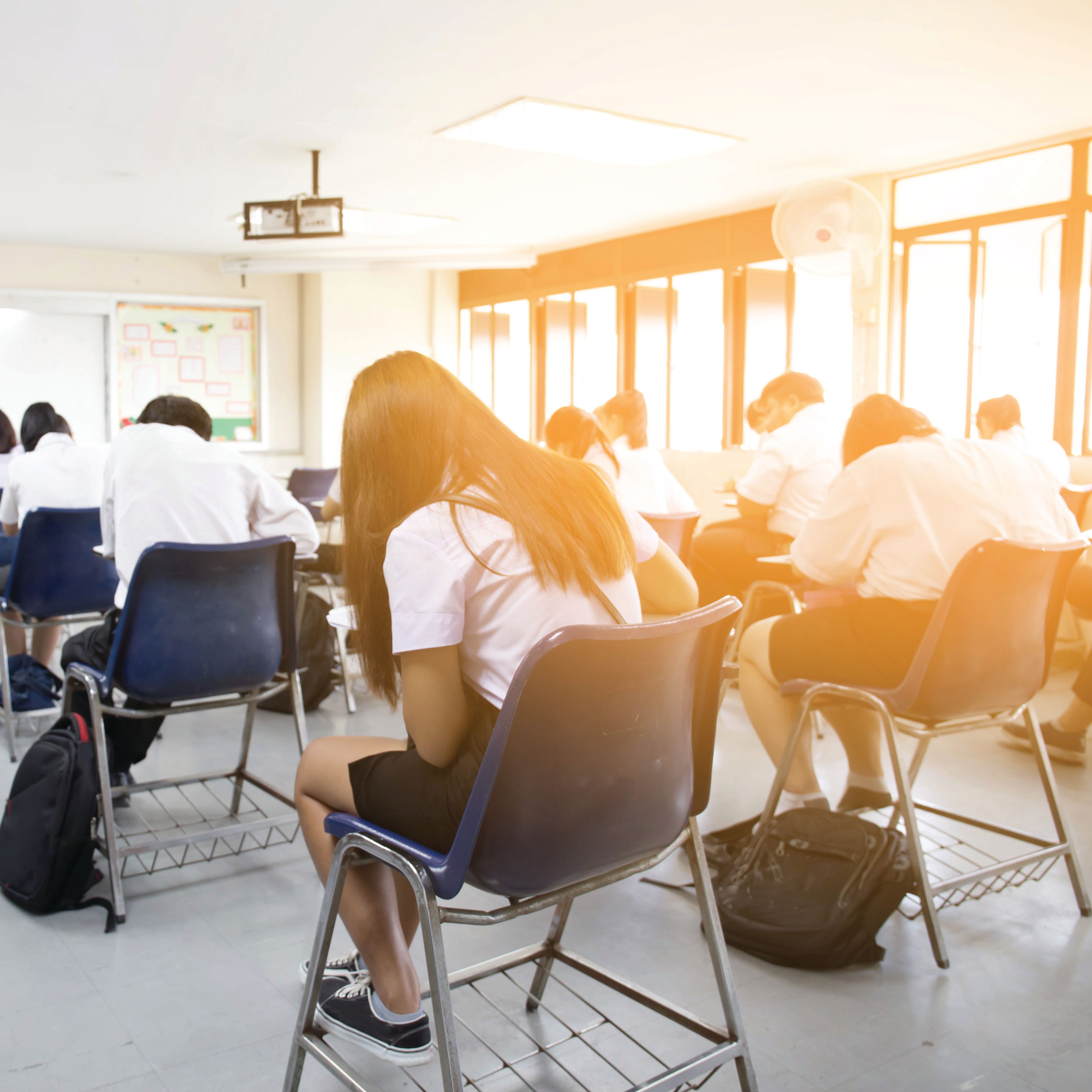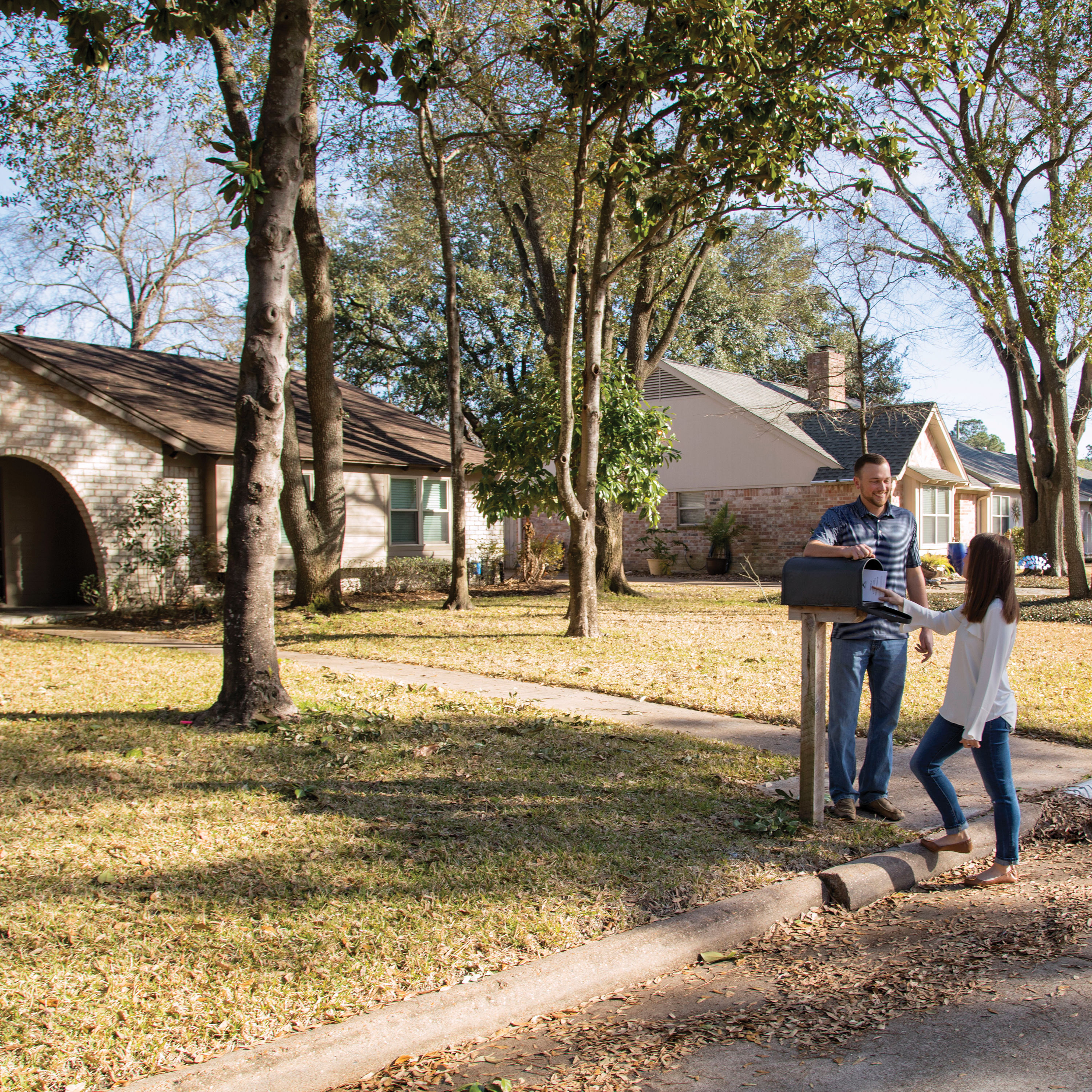Houston's Standout Public School Districts

Image: Laura Furr Mericas
You know what they say: Houston is a great place to raise kids. But when it comes to public education, we may need to amend that statement: The areas just outside of Houston city limits are great places to raise kids. According to Children at Risk, the Texas-based public education research and policy nonprofit, districts with the highest percentage of students who meet the state’s STAAR-testing requirements remain almost entirely outside of the Beltway, with the city’s central district, HISD, lagging behind.
Meanwhile, the school-aged population of our sprawling metro area is growing, something districts are trying to address. In 2017 alone, voters approved more than $2 billion in school bonds, with more on the way in the years ahead. Here’s what you need to know about Houston’s 16 top-performing school districts and 4 top-performing charter school systems, as they stand today.
Methodology: Data for the 50 largest school districts in the greater Houston area from the 2016-17 school year was provided by Children at Risk. For each district, we took the percentage of students who met state reading standards, and averaged them with the percentage who met state math standards. Those with the 20 highest scores (school districts and charter school systems) were included here.
Friendswood ISD
Percentage of students meeting reading standards: 71% | Percentage of students meeting math standards: 73%
This wealthy district has high academic ratings across the board. The average SAT score, 1623, is the highest across the metro, as is the percentage of students who meet STAAR standards in reading.
Tomball ISD
65% | 71%
More than 94 percent of students here make As and Bs, and about 87 percent of students graduate. Last year the district passed a $275 million bond that will add a new elementary school and junior high.
Barbers Hill ISD
64% | 70%
This growing suburban district in West Chambers County boasts the smallest average classroom size among the top-performing districts in the metro, with a student-teacher ratio of about 14:1.
Montgomery ISD
61% | 64%
New elementary and junior high schools opened in this district north of town last year, and the community’s second high school opened in August, courtesy of the $257 million bond passed in 2015.
Katy ISD
64% | 63%
Every campus within this diverse suburban district met statewide learning standards in 2016. Thanks to a voter-approved $609 million bond, Katy ISD will add six new schools and make technology and infrastructure improvements by 2021. Its $70 million, 12,000-seat Legacy Stadium, which opened last season, remains the most expensive high-school sports venue in the state.
Pearland ISD
62% | 61%
Residents of this suburb south of Houston—consistently one of the top-performing districts in the greater Houston area—approved a $220 million bond in 2016, which will be put toward new classrooms and facilities for technical, fine arts, and agricultural education, plus an expansion of the district’s sports complex, known as The Rig.
Conroe ISD
58% | 60%
This spring builders broke ground on the final two schools funded by a $487 million bond approved by voters in 2015. An elementary school, a “prototype” K-6 school, and new middle and high schools are being added to help curb congestion, as the district is expected to take on an additional 8,000 students by 2020. This summer, the district’s board announced that it’s considering putting another bond to a vote, possibly as soon as May 2019.
Clear Creek ISD
59% | 57%
This League City district, which is at over 90 percent capacity, last year passed a $487 million bond to build new schools, replace portable structures with permanent additions, and renovate aging campuses. Most students here maintain a B average.
Fort Bend ISD
56% | 56%
For months concerned parents have flooded heated board meetings in this Sugar Land–based district, taking sides on how to allocate funds in this fast-growing area with a number of aging facilities. The board agreed to put its largest bond program ever to a vote this November. The first, $992 million phase would build four new schools, renovate older campuses, update security and technology, and make additional land purchases. The second, slated to roll out in 2021, has a price tag of $705 million. This comes after the $484 million bond that was approved in 2014, adding four schools and the $59 million James Reese Technical Center, which has been in the news lately, as construction workers have discovered 95 unmarked graves belonging to prisoners forced to work in the state’s Jim Crow–era convict-leasing program. FBISD plans to work with the Texas Historical Commission to “identify an appropriate location for reburial” as the project continues.
Lamar CISD
53% | 57%
Schools in this district, home to Rosenberg, are smaller, with a capacity of about 2,000 students. A $445 million bond passed last year is slated to add a new high school and junior high, plus three elementary schools.
Cypress-Fairbanks ISD
53% | 53%
Home to over 100,000 students, this high-performing district is the second-largest in the metro area and the third-largest in the state. In 2014 residents passed a massive $1.2 billion bond that’s slated to add three new elementary schools and a junior high, plus a natatorium and transportation, food-distribution, and agricultural centers, by 2020.
Needville ISD
52% | 50%
The smallest among top performers, this rural Fort Bend district has only four schools. About 88 percent of the 1,000 high schoolers graduate on time.
Deer Park ISD
48% | 53%
Last year voters in this mid-sized district approved a $156 million bond that calls for renovations to two area junior high schools, the rebuilding of one elementary school and demolition of another, and the relocation of a sports stadium, plus upgrades to equipment across the board—from HVAC systems to school buses, library books to cafeteria ovens.
Humble ISD
52% | 49%
Enrollment in this fast-growing area is expected to increase by nearly 25 percent by 2025. To prepare, the district called for, and passed, its first bond in 10 years this May, for $575 million. Projects include the addition of two new schools, a second transportation center, and an expansion of the district police station.
Klein ISD
51% | 48%
This fast-growing district passed a $498 million bond in 2015 that will add four new campuses, expand nine more, and create a 1:1 student-computer ratio.
La Porte ISD
48% | 46%
After the passage of a $260 million bond in 2014, this coastal district recently wrapped construction of two new campuses and upgrades to La Porte High. Updates to the district’s planetarium—yes, planetarium—originally built in 1964 are also in the works.

Image: Shutterstock
Top-Performing Houston-Area Charter School Systems
Houston Gateway Academy Inc.
62% | 85%
The vast majority of students at this public charter school (about 92 percent) are considered economically disadvantaged, and 43 percent of students are English language learners (ELL). Still, the district maintains the highest average percentage of students meeting state standards in the greater Houston area.
Harmony Charter Network
53% | 56%
This network of STEM charter schools, founded in Houston, has expanded throughout the state. About 57 percent of Houston-based students are considered economically disadvantaged; 100 percent of students get into college, and about 60 percent are the first in their family to attend.
Yes Prep Public Schools Inc.
45% | 54%
One of the largest and most recognizable charter districts in the city, Yes Prep aims to quadruple the number of college-ready graduates from its schools by 2020. This school year, it opened its 17th campus for grades 6–12, in the Northline area, and has plans to open three more in the next two years. The district is known for its small class sizes, high graduation rates, and diverse students, many of whom are underprivileged.
KIPP Inc. Charter
49% | 48%
Also known as the Knowledge Is Power Program, KIPP was founded in Houston in 1994—they have 28 schools—and has grown to include over 200 schools across the country. More than 90 percent of students are classified as economically disadvantaged, and more than 93 percent graduate.
Missing the Cut: Houston ISD
39% | 40%
HISD is the largest district in the state and the seventh-largest in the country, but it falls toward the middle of the pack academically. About 78 percent of the district’s 200,000-plus students graduate on time, and about a third of them maintain As and Bs. But on average, about 40 percent of students meet state STAAR standards for reading and math. Still, some of the top public schools in the city are in this district—last year all of Houston’s five best high schools were in HISD. Families just have to live in the right spot in the right neighborhood, or apply to special subject-specific or magnet programs, to get in. In May administrators recommended that the district put a $1.7 billion bond package to a vote in 2019. If approved, it would be the first for HISD in seven years. The district’s latest bond, approved in 2012, is about 70 percent complete, funding construction and renovations on 10 schools that opened this school year, with more to come.
















